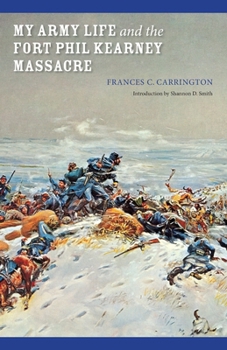My Army Life and the Fort Phil Kearney Massacre: With an Account of the Celebration of "Wyoming Opened"
Select Format
Select Condition 
Book Overview
First published in 1910, Frances C. Carrington's My Army Life and the Fort Phil Kearney Massacre recounted the author's adventures as an army wife on the Great Plains, but also sought to set the record straight on her second husband's involvement in the Fetterman fight. Frances traveled with her first husband, Lt. George Washington Grummond, to Fort Phil Kearney in Wyoming in 1866 where he was killed in the Fetterman incident just a few months later. She eventually married the post commander, Col. Henry B. Carrington, after the death of his first wife, Margaret, who had befriended and cared for Frances during her brief, tragic episode at the frontier post. Frances's narrative recalls the wonder and worries of a naive young bride during the fateful days of 1866. From her voyage to Wyoming to her encounters with unfamiliar peoples and strange landscapes, Frances's vivid prose examines not only the everyday workings of a frontier army post but also the political and social intrigue behind one of the most controversial military defeats in Western history. Shannon Smith Calitri is a professor of history at Oglala Lakota College.
Format:Paperback
Language:English
ISBN:0803264437
ISBN13:9780803264434
Release Date:May 2004
Publisher:Bison Books
Length:318 Pages
Weight:0.90 lbs.
Dimensions:0.8" x 5.4" x 8.0"
Customer Reviews
1 rating
Significant of Early Wyoming
Published by Thriftbooks.com User , 19 years ago
The 1860's were turbulent years throughout the west and the Big Horn Mountains of Wyoming were no exception. Francis Carrington's reminisces of these times are essential to understanding not only army life on the frontier, but also the true facts of the horrid Fetterman Massacre of 1866. Venturing west as a young bride to Lt. George Grummond, she describes in detail the landscapes, people and day to day existence of trail life while on their way to establish Ft. Phil Kearney on the eastern flank of the Big Horn Mountains. The fort's purpose was to protect emigrants traveling to the gold fields of Montana. With the land initially promised to the Sioux in treaty, the government's newer policies of allowing a road and forts to be built through this region fueled acts of violence from the Sioux. Frances' husband Lt. Grummond, along with Lt. Colonel William Fetterman and a total of eighty-one men were led into ambush by the Sioux in December 1866 and all killed. The post commander, Colonel Henry Carrington, gave explicit orders which were disobeyed resulting in the slaughter of these men. An informative and expressive read which also upholds Colonel Carrington's command.






